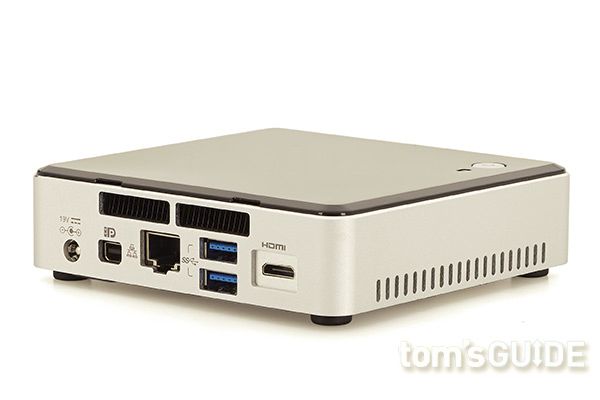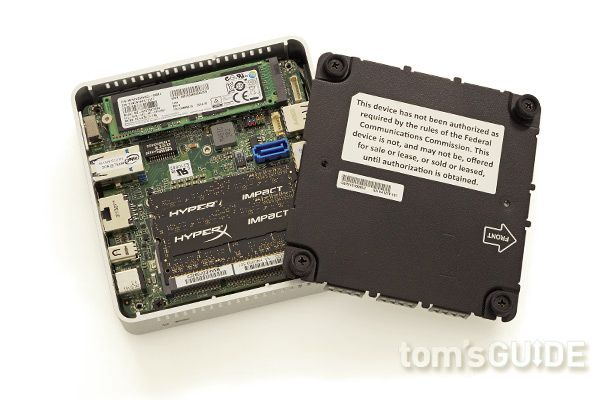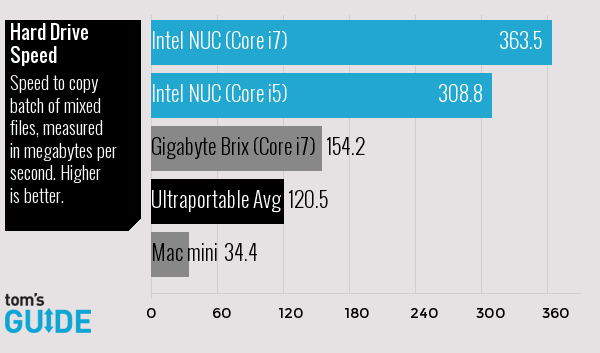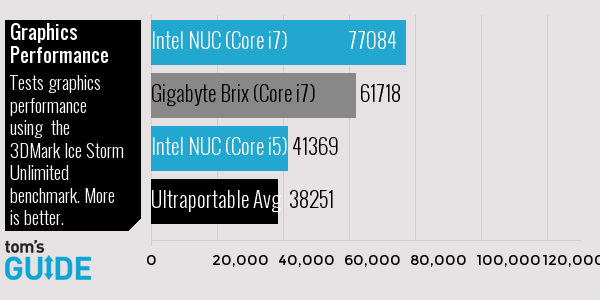Hp Compaq Pro 6300 All in One Pc Intel Quad Core I7 3770s Reviews
Tom'south Guide Verdict
The Intel NUC is a mini PC that delivers a surprising amount of ability in a compact and customizable chassis.
Pros
- +
Bonny compact design Strong functioning Supports fastest SSDs Replaceable lid adds functionality Outputs 4K, or to iii Monitors
Cons
- -
Doesn't come up with RAM, OS or storage
Until recently, if you wanted the power and versatility of a desktop, y'all had to clear plenty of space on the floor or a table for a tower. Today, mini PCs like Intel's NUC (Next Unit of Calculating) series brand ultraportable laptops await big. Fast enough to be your chief PC but small enough to fit anywhere, the 2015 NUCs feature Intel fifth-generation Broadwell CPUs, 802.11ac Wi-Fi and support for high-speed PCIe SSDs. Better still, there's a Cadre i7-powered configuration, the NUC5i7RYH, which operates at 3.ane GHz. If you're comfortable buying and installing your own RAM, storage and operating system — which brought the price of our Core i5- and Cadre i7-powered test units up to $670 and $770, respectively — Intel's mini PC has a lot to offer.
Utilize Cases
The Core i5-powered NUC5i5RYK ($369) is undoubtedly fast enough to be a primary PC for students, business users and productivity-minded consumers. By pairing the NUC with a high-res monitor (or two), you tin can accept all the space-saving benefits of an all-in-one PC, but with the power to continue your displays afterwards your next upgrade. The Core i7-powered NUC5i7RYH ($486), which nosotros also tested, is fast plenty to do hardcore productivity work, edit large videos or fifty-fifty do light gaming.
With a high-capacity drive inside or attached via USB, either NUC can also serve as a very stiff home-theater PC. Retailers with space concerns can employ the NUC in point-of-sale systems or kiosks.
Design
At 4.five 10 iv.4 x ane.iii inches and but one pound (with storage and RAM installed), the NUC5i5RYK is well-nigh the size and shape of a peanut butter and jelly sandwich. The NUC5i7RYH and some of the other NUC models are 0.6 inches taller, so they tin can incorporate a two.5-inch drive bay in add-on to the M.ii slot (for SSDs) on the motherboard. At either height, the NUC is tiny enough to slip into the smallest amusement center, sit next to the keyboard on your desk or strap to the back of a monitor, using the bundled VESA mounting bracket.

Even the NUC's AC adapter is rather small and unobtrusive, as it measures merely 1.75 x 3.25 x 0.9 inches and weighs a minor 6.five ounces. The Gigabyte Brix GB-BXi7H-5500 is most identical in size and shape to the NUC5i5RYK, at 4.ii x 4.5 x 1.iii inches. However, most mini-PC competitors are significantly larger, including the Apple Mac mini (7.7 ten 7.7 x 1.4 inches, 2.6 pounds), the Lenovo ThinkCentre M83 Tiny PC (seven x 7.2 x 1.35 inches, 2.nine pounds) and the HP Stream 200-010 Mini (v.73 x five.vii ten 2.1 inches, i.4 pounds).
Although you can easily hide the NUC in a cabinet or behind a display, its svelte and sexy blueprint makes it a bang-up showpiece for your office or living room. The NUC's chassis consists primarily of matte-silver aluminum, with a shiny, black, plastic lid and a matte, black, plastic lesser. The sides and the back are dotted with minor vents that brand the device look like a model spaceship, while a silver power button adds a touch of grade to the meridian.
The tiptop lid is hands removable, every bit we were able to pry it off without using any tools. Intel doesn't sell replacement lids on its ain. Yet, the visitor has made the specs available, so any company or private tin can create a custom lid with a design on it, or fifty-fifty with actress functionality. At CES 2015, the company showed off some prototype lids, including ane with a TV tuner and another with NFC. At press fourth dimension, in that location were no third-party lids for sale, but enterprising consumers can 3D print their own.

Ports and Connectivity
For a reckoner this modest, the NUC packs in a lot of ports. The front surface has a 3.v-mm headphone jack, an infrared receiver and two USB 3.0 ports, i of which remains on for charging devices while the organization is asleep. The back has the ability jack, a gigabit Ethernet port, both mini HDMI and mini DisplayPort connectors, and ii more USB 3.0 ports, for a total of four of those ports. A Kensington lock slot sits on the right side.

If you want to sentinel ultra-Hard disk drive content, the NUC can output to a monitor at full HD. Using a combination of its video ports, Intel's mini PC can also back up up to 3 displays at once. The DisplayPort supports DisplayPort 1.2 protocol and is capable of driving three different i,920 10 1,200 screens through a splitter or by daisy chaining. Notwithstanding, the easiest way to use multiple monitors is to attach i monitor to each port, provided you take both mini HDMI and mini DisplayPort cables.
If you're non using wired Ethernet to get online, you lot can connect using the NUC's Intel 7265 card, which provides 802.11ac Wi-Fi and Bluetooth four.0. The card can too beam video to your set-pinnacle box using Intel's WiDi standard.
Needed Parts and Their Costs
Intel sells the NUC but equally a bare-bones PC, which means that information technology comes without RAM, a storage bulldoze or an operating arrangement. Then, fix to spend at least $250 and a few minutes of your fourth dimension to get the system going.
The organisation has 2 DIMM slots, which accept 1.35-volt, DDR3L SODIMMS. You tin fill up either one or both with a total of upwardly to 16GB. It costs effectually $55 for 8GB of this type of RAM, though cost-conscious consumers can economize with a less-than-optimal 4GB stick for but $28.
MORE: All-time Wi-Fi Routers
The NUC's Grand.2 slot requires 22 x 42, 22 x sixty or 22 10 80 Thousand.2 SSDs with a type Yard or B+M keyed connector. The motherboard supports One thousand.two SSDs that use the SATA bus or the PCIe x1, x2 or x4. Translation: The NUC will work with almost any One thousand.2 SSD on the market. Well-nigh of those SSDs are SATA, which has an upper limit of about 540 MBps. You can buy a 250GB drive for around $120, with 120GB alternatives available for well less than $100.
Though more expensive, PCIe x4 drives are capable of speeds more than twice as fast as those of SATA. For our tests, we used a 256GB Samsung XP941, which uses PCIe x4 and costs around $250 simply offers read speeds of more than 1,000 MBps and write speeds of more than 800 MBps.
If you wish to install Windows, an original equipment manufacturer (nonupgrade) version costs almost $99. Various versions of Linux, such every bit Ubuntu, are bachelor for complimentary.

Installation and Setup
Adding the RAM and SSD takes less than five minutes. To get to the inside of the system, you just turn the NUC over and unscrew the bottom panel, which is attached past four standard-size Philips-caput screws. After that, it takes but a few moments to pop in the RAM, slide the SSD into the M.2 slot and tighten the screw that holds the bulldoze in identify.

Installing Windows takes 10 to 20 minutes. Just make certain you accept the installer on a bootable USB key and take downloaded the latest device drivers from Intel's site.
Functioning
With its ane.6-GHz Intel fifth-generation Broadwell Core i5-5250U CPU, which tin can turbo up to ii.7 GHz, the Intel NUC5i5RYK is more than than fast enough for serious productivity tasks like crunching spreadsheets, surfing the Web, viewing 4K videos or even editing videos.
During testing, it took the Core i5-powered NUC just ane minute and 8 seconds to transcode a 2:30 movie trailer from 1080p to 720p using Windows Movie Maker while a 4K video played in another window. Its Core i7-powered sibling was just a little faster, finishing in 1 minute and 3 seconds.
Because they both employ mobile CPUs, the NUCs' benchmark scores are more on a par with those of ultraportable laptops than those of desktops, which employ more than power, have 4 cores and often run at higher clock speeds. Having a mobile CPU has its advantages in a desktop, though. Throughout our testing, the NUC5i5RK remained cool to the touch, and although information technology has a fan, information technology was likewise extremely quiet. The NUC5i7RYH fabricated some audible fan racket while compressing a video, all the same.
MORE: Best Gaming Desktops
Our Cadre i5 and Core i7 test units, both of which had 8GB of RAM and a blazing-fast Samsung XP941 SSD, scored v,611 and 7420, respectively, on Geekbench 3, a synthetic test that measures overall operation. The Cadre i5 model'south score is a chip lower than the all-in-i desktop category average of 7,013 but comfortably ahead of the 4,037 ultraportable laptop average and Core i5-powered Mac mini (5443), while its big brother outperforms a typical all-in-1. The Core i7-powered Gigabyte Brix GB-GXi7H-5500 wasn't quite equally fast equally the Cadre i7-powered NUC, returning a score of vi,425.

Both NUCs showed they are more capable of handling serious office work, completing our Spreadsheet Performance Test (matching xx,000 names with addresses in OpenOffice) in but 5 minutes and 2 seconds for the Cadre i5 model and an even 4 minutes for the Core i7 unit of measurement. Both mini PCs are more than twice every bit fast as the ultraportable notebook category average (10:17) and also faster than the 7-minute all-in-one category average. The Brix'due south fourth dimension of iv:31 falls betwixt the NUCs, while the Mac mini (6:17) trails the field.

With their superspeedy PCIe x4 SSDs, the NUC5i5RYK and NUC5i7RYH completed our File Transfer Test, which involves copying four.97GB of files, in only sixteen and fourteen seconds, respectively, for rates of 308.8 MBps and 363.5 MBps. Those are 2 of the fastest rates we've seen on whatsoever reckoner, and miles ahead of the all-in-ane category average (58 MBps) and the ultraportable notebook average (120.5 MBps).

Graphics Functioning
The Core i5-powered NUC5i5RYK is powered by an Intel HD Graphics 6000 GPU, while the Cadre i7-enabled NUC5i7RYH has faster Hard disk Graphics 6100 "Iris" graphics. Both GPUs are more than adequate for watching 4K videos, but only the Cadre i7 model is recommended for playing some mainstream games.
On 3DMark Water ice Strom Unlimited Strike, a synthetic criterion that measures overall graphics prowess, the NUCs scored 41,369 and 77,084, respectively. That's much better than the ultraportable average (38,251), only the Brix (61,718) did a bit better than the Cadre i5 NUC.

When we played Earth of Warcraft at autodetect settings and ane,366 x 768 resolution, the Cadre i5 NUC managed a playable frame rate of 37 fps, just that number dropped to a mediocre 26 fps at 1080p. The Core i7 NUC delivered much stronger rates of 65 and 41.5 fps — much better than the ultraportable averages of 33.seven and 31.v fps. The Gigabyte Brix managed 61.vii and 39 fps. Yet, when we turned the settings upward to ultra, Intel's mini PCs offered slideshowlike 16 and 18.7 fps rates at 1080p.
Configuration Options
Intel sells several versions of the 2015 NUC, each with slightly different options. The base model goes for $295 and has a ii.ane-GHz Core i3-5010U CPU. A version that'south just 0.half-dozen inches taller and has a ii.v-inch drive bay goes for simply $5 more. Our Core i5-powered exam system retails for $369, but there's also a version with a 2.5-inch drive bay, the NUC5i7RYH, which goes for $379.
The Core i7-powered NUC5i7RYH is available for $486 and comes only in the 1.ix-inch-tall size. There are also business-friendly versions of each configuration that have Intel's vPro management technology and two mini DisplayPorts in lieu of the mini HDMI + mini DisplayPort.
We strongly recommend getting an NUC with the 2.v-inch drive bay, because it gives you two storage devices: a spacious mechanical hard drive and a fast One thousand.2 SSD.
Core i5 vs. Core i7
Roughly $100 stands between the Core i5-powered NUC5i5RYK ($369) and the Core i7-powered NUC5i7RYH ($486). If you program to use the device for mainstream work or inside a kiosk or sign, the Core i5 model should provide more-than-adequate performance while generating less fan dissonance than its sibling. Withal, if you want to practice processor-intensive tasks, such as editing big media files or crunching giant spreadsheets, the added performance from the Cadre i7 CPU is worth the money.
Value
If you lot buy a standard NUC with a 256GB SATA Chiliad.2 SSD, 8GB of RAM and an OEM copy of Windows, your $390 Core i5-powered NUC will actually cost well-nigh $670, and the Cadre i7 model will cost $100 more than. Going with 4GB of RAM, a 128GB SSD and a free operating system lowers the total prices to $490 and $590 for the Core i5 and Core i7 systems, respectively.
What you're paying for with the NUC is the combination of small size and big operation, peculiarly if you employ the PCIe x4 SSD. If you desire a ready-made mini PC with all of its parts and software installed out of the box, you can find less-expensive systems with much slower processors and no SSD. The HP Stream 200-010 mini, for example, costs $179 simply is half a pound heavier and more than than an inch larger on each side, and uses a slow Intel Celeron CPU, 2GB of RAM and a 32GB storage drive.
For businesses, Lenovo's ThinkCentre M83 Tiny Desktop is most twice the size and three times the weight of the NUC, just it comes with all its parts installed and starts at $483 for an Intel 4th-gen Core i3 model with a 500GB hard drive. A Core i5 model with an SSD and 8GB goes for more than $i,000. The Mac mini also looks large next to the NUC and starts at $499 for a Core i5 model with a hard drive; an SSD version starts at $699.
Bottom Line
You'll come for the tiny, attractive design, but you'll stay for the stiff performance. Those who don't want to go through the hassle of installing their own RAM, storage and Os may prefer a larger and more expensive mini PC similar the Mac mini or the ThinkCentre M83. Serious gamers will want a larger desktop or a laptop with discrete graphics. However, if you're willing to put in a little elbow grease and you need a small desktop to apply equally your primary PC or for your home theater, Intel'due south Broadwell-powered NUC is the best selection yet.
- Best All-in-One PCs
- Laptop Interactive Ownership Guide
- Top x Windows 10 Features
Source: https://www.tomsguide.com/uk/us/intel-broadwell-nuc-mini-pc,review-2688.html